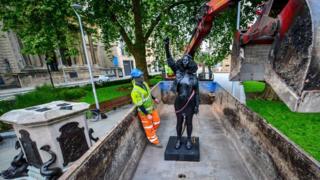 Image copyright
PA Media
Image caption
The sculpture was removed at 05:30 BST on Thursday having been in place for just over 24 hours
Image copyright
PA Media
Image caption
The sculpture was removed at 05:30 BST on Thursday having been in place for just over 24 hours
A sculpture of a Black Lives Matter protester has been removed from the plinth where a statue of slave trader Edward Colston once stood.
The sculpture of Jen Reid was erected on Wednesday but removed by Bristol City Council just over 24 hours later.
Ms Reid had been photographed standing on the empty plinth after the Colston statue was pulled down during protests.
Mayor Marvin Rees said it was up to the people of Bristol to decide what would replace the Colston statue.
Bristol City Council tweeted to say it had removed the sculpture on Thursday morning and it would be held at its museum "for the artist to collect or donate to our collection".
Image copyright EPA Image caption Jen Reid posed with her statue, which appeared on the empty plinth on WednesdayCouncil contractors arrived at the sculpture on Thursday morning and it had been removed and taken away in the back of a lorry by 05:30 BST.
On Wednesday, Mr Rees tweeted: "I understand people want expression, but the statue has been put up without permission.
"Anything put on the plinth outside of the process we've put in place will have to be removed."
The black resin statue, called A Surge of Power, was created by artist Marc Quinn and designed to be a temporary installation to continue the conversation about racism.
He said he was inspired to create it after seeing an image of Ms Reid standing on the plinth with her fist raised during the Black Lives Matter protest on 7 June.
Mr Quinn then contacted Ms Reid through social media and they worked together on the statue, which was erected shortly before 04:30 on Wednesday.
Image caption The new statue attracted people both supporting it and those against it on Wednesday Image copyright PA Media Image caption Bristol City Council said the sculpture of Ms Reid would be moved to a museum after its removal
 5 years ago
635
5 years ago
635 

